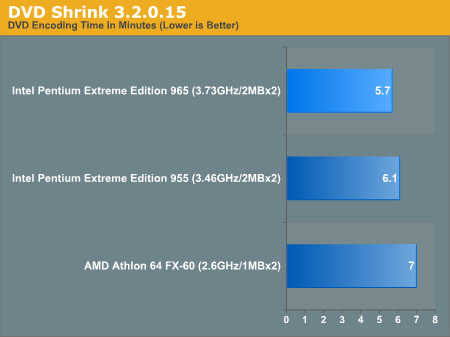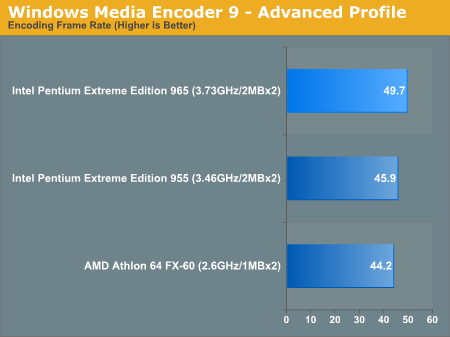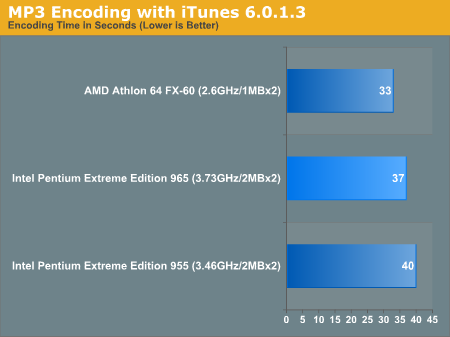Intel's Pentium Extreme Edition 965: The Last of a Dying Breed
by Anand Lal Shimpi on March 22, 2006 1:51 PM EST- Posted in
- CPUs
Media Encoding Performance using DVD Shrink, WME9, Quicktime and iTunes
First up is DVD Shrink 3.2.0.15. Our test was simple - we took a copy of Star Wars Episode VI and ripped the full DVD to the hard drive without compression, effectively giving us an exact copy of the disc on the hard drive. Then, using the copy of the DVD on the hard drive (to eliminate any DVD drive bottlenecks), we performed a DVD shrink operation to shrink the movie to fit on a single 4.5GB DVD disc. All of the options were left on their defaults, so the test ends up being pretty easy to run and reproduce. The scores reported are DVD encoding times in minutes, with lower numbers meaning better performance.
The DVD Shrink test is quite important as DVD Shrink is quite possibly one of the easiest tools to rip a DVD. The easier a tool is to use, the more likely that it's going to be used, and arguably the more important performance using it happens to be.
Moving on, we have our Windows Media Encoder 9 test, which uses the advanced profile settings for video encoding. We left all settings at their defaults and just proceeded with a MPEG-2 to WMV-HD conversion. The values reported are in frames per second, with higher numbers being better.
Next up, we have Quicktime Pro 7.0.3 and we perform a MPEG-2 to H.264 encoding task. We've changed our test a bit to make it more streamlined. The export settings are left on their Export to Quicktime Movie defaults (which happens to be a H.264 export). We simply changed the audio encoder to use Apple's AAC codec instead. We report the transcoding time in minutes, with lower values being better.
Finally, we have a MP3 encoding test using iTunes 6.0.1.3. For this test, we simply took a 304MB wav file and converted it to a 192kbps MP3 file, measuring the encode time in seconds. The only iTunes option that we changed was to prevent the playback of the song while encoding.
First up is DVD Shrink 3.2.0.15. Our test was simple - we took a copy of Star Wars Episode VI and ripped the full DVD to the hard drive without compression, effectively giving us an exact copy of the disc on the hard drive. Then, using the copy of the DVD on the hard drive (to eliminate any DVD drive bottlenecks), we performed a DVD shrink operation to shrink the movie to fit on a single 4.5GB DVD disc. All of the options were left on their defaults, so the test ends up being pretty easy to run and reproduce. The scores reported are DVD encoding times in minutes, with lower numbers meaning better performance.
The DVD Shrink test is quite important as DVD Shrink is quite possibly one of the easiest tools to rip a DVD. The easier a tool is to use, the more likely that it's going to be used, and arguably the more important performance using it happens to be.

Moving on, we have our Windows Media Encoder 9 test, which uses the advanced profile settings for video encoding. We left all settings at their defaults and just proceeded with a MPEG-2 to WMV-HD conversion. The values reported are in frames per second, with higher numbers being better.

Next up, we have Quicktime Pro 7.0.3 and we perform a MPEG-2 to H.264 encoding task. We've changed our test a bit to make it more streamlined. The export settings are left on their Export to Quicktime Movie defaults (which happens to be a H.264 export). We simply changed the audio encoder to use Apple's AAC codec instead. We report the transcoding time in minutes, with lower values being better.

Finally, we have a MP3 encoding test using iTunes 6.0.1.3. For this test, we simply took a 304MB wav file and converted it to a 192kbps MP3 file, measuring the encode time in seconds. The only iTunes option that we changed was to prevent the playback of the song while encoding.

3D Rendering Performance using 3dsmax 7
Gaming Performance using Battlefield 2, Call of Duty 2 and Quake 4










41 Comments
View All Comments
whitelight - Wednesday, March 22, 2006 - link
what cpu do you think it is? an opty 144?
swtethan - Wednesday, March 22, 2006 - link
P-D 805 probablypnyffeler - Wednesday, March 22, 2006 - link
I've always been a huge supporter of AMD, but parts of me get all tingly when I think of Conroe on the horizon.Talk about switching teams...
Googer - Thursday, March 23, 2006 - link
AMD could possibly be more competitive with a 4 MB cache instead of 2MB the Current Athlon 64 has. It may or may not help much but conroe also has a 60MHz advantege over A64.BrownTown - Wednesday, March 22, 2006 - link
Can we get some HT disabled tests, the replay bug really messes with these chips performance in some apps, would be nice to see how disabling HT would help in some apps. Its usually like a 50:50 split, so if you have a specific use then there is a good possibility you will likely get better performance than these benchmarks suggest in certain apps.allometry - Wednesday, March 22, 2006 - link
I don't think there is anything wrong with how you feel about AMD and Intel. I think the majority of geeks have been used to rooting for the underdog, AMD, for the past couple years. AMD was cranking out superior chips in comparison to Intel's.But now, Intel is back as the powerhouse we once knew. This is competition and it is what we should have all been rooting for instead of just the underdog. Sure, it's easy to get wrapped up in the benchmarks and post ubsurd comments such as, "AMD is t3h pwnz0rz0x0x!!11", but now, it's time to be realistic and say that Intel's back with something that isn't the suck.
I'm happy with my AMD setup and in the future, if money presents itself, Intel may once again have a place in my pocket book. Let's just hope that AMD comes back with something competitive to Conroe!
Regs - Wednesday, March 22, 2006 - link
The Power house we once new stood by itself with a P3 that ran quake and ms excel with the help of 3DfX voodoo. When did Intel ever have the lead in 3D games? Before the K8? This was...8 years ago? This is exactly why people route for the "underdog". As far as im concerned, AMD has always been the superior technology for gaming and overall efficiency no matter what Intel said or threw at it. We have finally reached a new cycle for processing, visual effects, and programming. AEGIA's physics processor concept, Windows Vista, Intel's conroe, AMD's new born, and DX9/DX10 gaming are right around the corner. Yes, exciting times are ahead.defter - Thursday, March 23, 2006 - link
Athlon64 was released 2.5 years ago...
MrKaz - Thursday, March 23, 2006 - link
Have you hear of Athlon, then Athlon XP, ... and it wasnt 2.5 years ago...SUNNYVALE, CA -- January 31, 2003 --AMD (NYSE:AMD) today announced that the worldwide introduction of its next-generation, 64-bit AMD Opteron™ processor for servers and workstations will take place on April 22 in New York City. AMD plans to follow up with the introduction of the AMD Athlon™ 64 processor for the desktop and mobile markets in September 2003.
The first Athlon (the P3 killer and the more recent P4 killer) was released in June 23, 1999.
LoneWolf15 - Thursday, March 23, 2006 - link
The Athlon and Athlon XP were K7 chips, not K8. Therefore, the reply makes sense.